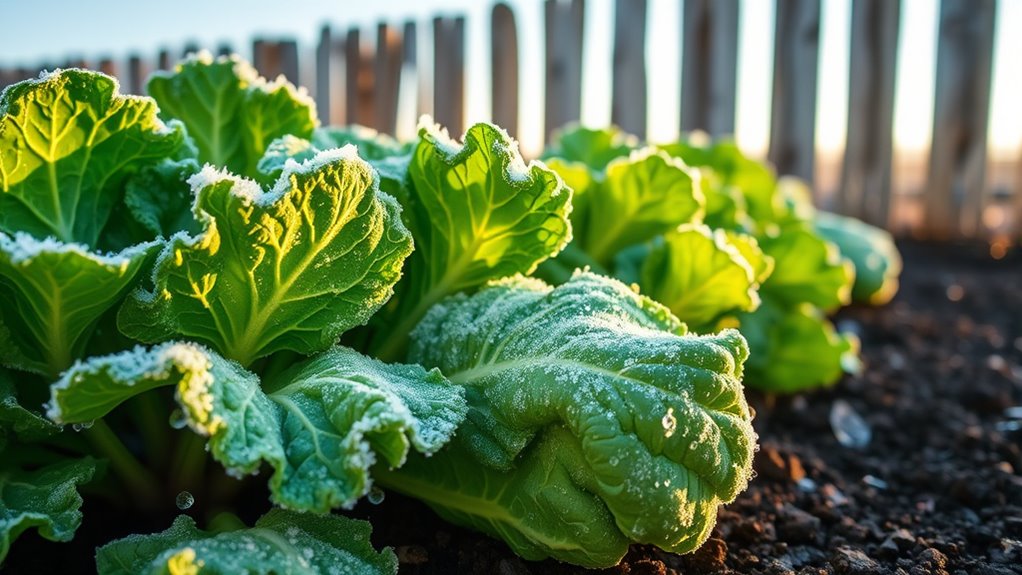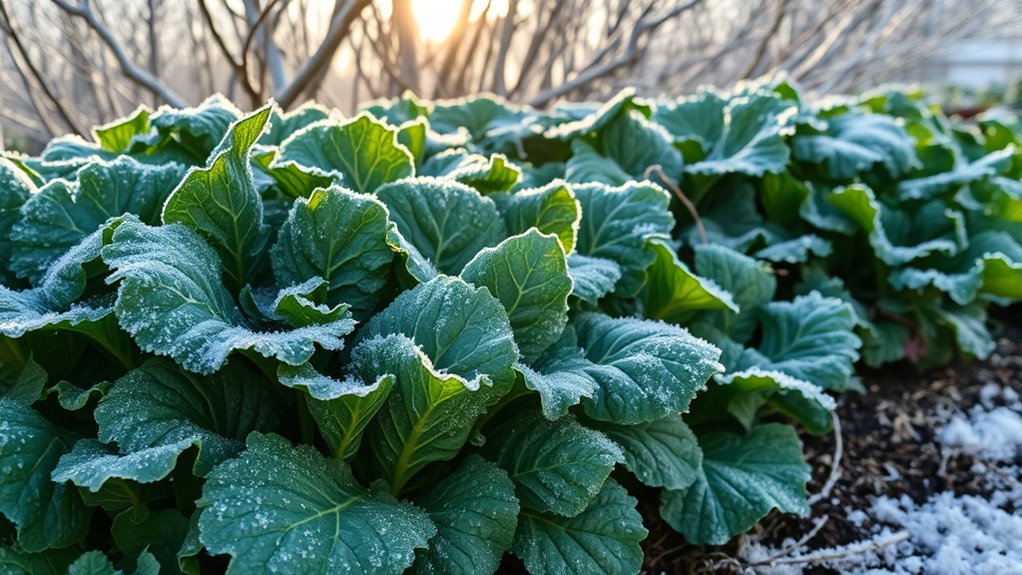If you want to grow winter greens, start with frost-hardy varieties like kale, spinach, and arugula. Protect them from harsh conditions using frost cloths or hoop houses. Make sure they receive enough sunlight and nutrients, as cold temps can slow growth. Timing is key—plant them eight weeks before the first frost. With the right care, you’ll enjoy nutritious greens all winter long. Discover the best methods and tips to maximize your winter harvest!
Key Takeaways
- Plant winter greens like kale, spinach, and arugula in late summer or early fall, about eight weeks before the first frost.
- Use frost cloths, hoops, or hoop houses to protect greens from freezing temperatures while allowing sunlight and air circulation.
- Ensure nutrient-rich, well-draining soil with sufficient nitrogen and essential micronutrients for optimal growth in cold weather.
- Regularly mulch with organic materials to insulate roots and maintain moisture levels during harsh winter conditions.
- Select frost-tolerant varieties that can thrive in temperatures as low as 15°F for successful winter gardening.
Types of Winter Greens

Winter greens are a fantastic choice for gardeners looking to grow nutritious leafy vegetables even in colder months. Kale and collard greens thrive in frost, providing essential vitamins and minerals.
Spinach loves the chill, packing a punch of nutrients, while Swiss chard adds colorful flair to your garden and plates. If you enjoy a peppery kick, arugula grows quickly and tolerates cold well.
Spinach flourishes in the cold, while Swiss chard brightens your garden. Arugula offers a zesty touch, thriving in winter’s chill.
Mustard greens bring a spicy flavor, perfect for salads or cooking, while turnip greens add a bitter touch to soups. For something less common, consider chicory or mache, both hardy and flavorful.
With such variety, you can enjoy fresh greens all winter long, enhancing your meals and boosting your health.
Methods for Protecting Winter Greens

Growing a variety of winter greens can be rewarding, but protecting them from frosty conditions is key to a successful harvest. One effective method is using frost cloth covers, which let sunlight and water in while shielding your plants.
If you prefer plastic covers, make sure to support them with hoops to prevent direct contact. Mulching with organic materials insulates roots against freezing temperatures.
You can also set up hoop houses for a warmer environment or employ overhead irrigation to maintain a protective layer of ice during light freezes. Each of these strategies helps ensure your winter greens thrive despite the cold, giving you a bountiful harvest when the weather warms up.
Best Conditions for Winter Greens

To successfully cultivate winter greens, you’ll need to create the right conditions that support their growth. First, ensure your plants receive sufficient sunlight, even though they need less light than summer crops.
Many winter greens are frost-tolerant, thriving in temperatures as low as 15°F, so choose varieties accordingly. Provide nutrient-rich soil with good drainage, and maintain consistent moisture without overwatering.
Protect your greens from harsh winds, which can damage their health. Consider using mulch to retain warmth and row covers for added frost protection.
Finally, pay attention to air circulation to prevent moisture buildup and disease, ensuring your winter greens flourish throughout the colder months.
Timing for Planting Winter Greens

As the days begin to shorten and temperatures cool, knowing when to plant winter greens becomes crucial for a successful harvest. Aim to plant most winter greens in late summer or early fall, about eight weeks before your area’s first frost date.
If you live in a colder climate, start as early as August 1st; warmer regions can begin later. Many winter greens, like lettuce and kale, can withstand light frosts, so don’t worry too much about the cold.
You can also start seeds indoors under grow lights to get a head start. Consider direct sowing about six to eight weeks before the frost, and choose cold-hardy varieties suited to your climate for the best results.
Nutritional Requirements for Winter Greens

Planting winter greens successfully involves more than just timing; understanding their nutritional requirements is key to fostering robust growth.
You need to ensure your soil has sufficient nitrogen, as cold temperatures slow photosynthesis. Active microbial life in the soil supports nutrient cycling, which is vital for plant health.
Don’t forget essential micronutrients like calcium and boron, often provided through specific fertilizers. Use balanced NPK fertilizers to support overall plant health, and consider organic options for long-term soil fertility.
Regular soil testing helps maintain optimal nutrient levels, while weekly fertilization boosts growth.
Benefits of Winter Greens

Winter greens offer a multitude of benefits that make them a valuable addition to your diet and garden.
They’re rich in antioxidants, promoting heart and vision health while potentially preventing certain cancers. Including these greens in your meals supports strong bones due to their calcium content.
Environmentally, winter greens improve soil health, boost biodiversity, and use less water, making them a sustainable choice.
Economically, they extend the growing season and meet winter market demand, benefiting local farmers.
Plus, their unique flavors and versatility in dishes encourage culinary creativity.
With their cold tolerance and ease of growth, winter greens are perfect for any gardener looking to enhance their harvest and health year-round.
Frequently Asked Questions
How Do I Know When to Harvest Winter Greens?
To know when to harvest winter greens, watch for their maturity. They should be nearly full size, and it’s best to harvest when temperatures are above freezing.
Aim to pick them during the warmest part of the day, ideally on sunny days to reduce nitrate buildup. Remember, different varieties have specific timeframes, so keep an eye on growth rates and harvest before daylight drops below 10 hours to ensure the best quality.
Can Winter Greens Be Grown Indoors?
Imagine a small garden thriving in your living room, where leafy greens flourish despite the chilly weather outside.
Yes, you can definitely grow winter greens indoors! They thrive in cooler temperatures and require less light than other veggies.
Just ensure you use proper lighting, maintain humidity, and choose compact growing systems.
With a little care, you’ll enjoy fresh, homegrown greens right from your indoor oasis, even when winter’s in full swing.
What Pests Affect Winter Greens?
Pests can significantly impact your winter greens.
You’ll likely encounter aphids, which damage leaves and spread viruses. Caterpillars might munch on your crops, leaving shredded foliage.
Slugs and snails can create holes in tender leaves, while rabbits and deer may feast on your plants if other food is scarce.
To protect your greens, consider using biological controls like lacewings or organic insecticides. Staying vigilant will help you manage these pests effectively.
How Can I Store Harvested Winter Greens?
To store your harvested winter greens, first clean them by rinsing off dirt and trimming any damaged parts.
Allow them to air dry before placing them in plastic bags or airtight containers to maintain humidity.
Keep your greens in a cool, dark place, ideally your refrigerator, at temperatures between 38-42°F.
Regularly check for spoilage and consume the older greens first to ensure freshness and minimize waste.
Are Winter Greens Suitable for Container Gardening?
Imagine a cozy cabin nestled in a snowy forest, where vibrant greens peek through the frost.
Yes, winter greens are perfect for container gardening! You can easily cultivate kale, spinach, and lettuce in pots, allowing them to flourish even in cold.
Choose larger containers for better protection and ensure they get enough sunlight.
With a little care, you’ll enjoy fresh, leafy harvests right from your balcony, bringing life to the winter landscape.
Conclusion
In conclusion, growing winter greens can be a rewarding experience, especially when you realize that they can provide up to four times the amount of vitamins compared to their summer counterparts. With the right methods for protection and care, you can enjoy fresh, nutritious greens all winter long. So, embrace the chill and get your hands dirty; you’ll not only enhance your meals but also boost your health with these vibrant, leafy vegetables!









